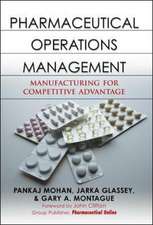Dynamics for Engineers
Autor S Banerjeeen Limba Engleză Paperback – 23 iun 2005
| Toate formatele și edițiile | Preț | Express |
|---|---|---|
| Paperback (1) | 428.58 lei 6-8 săpt. | |
| Wiley – 23 iun 2005 | 428.58 lei 6-8 săpt. | |
| Hardback (1) | 1046.22 lei 6-8 săpt. | |
| Wiley – 23 iun 2005 | 1046.22 lei 6-8 săpt. |
Preț: 428.58 lei
Preț vechi: 465.84 lei
-8% Nou
Puncte Express: 643
Preț estimativ în valută:
82.01€ • 87.70$ • 68.38£
82.01€ • 87.70$ • 68.38£
Carte tipărită la comandă
Livrare economică 17 aprilie-01 mai
Preluare comenzi: 021 569.72.76
Specificații
ISBN-13: 9780470868447
ISBN-10: 0470868449
Pagini: 296
Dimensiuni: 173 x 243 x 16 mm
Greutate: 0.57 kg
Ediția:New.
Editura: Wiley
Locul publicării:Chichester, United Kingdom
ISBN-10: 0470868449
Pagini: 296
Dimensiuni: 173 x 243 x 16 mm
Greutate: 0.57 kg
Ediția:New.
Editura: Wiley
Locul publicării:Chichester, United Kingdom
Public țintă
A must have resource for undergraduates and graduates students in electrical and mechanical engineering. Essential tool for lecturers in mechanical, electrical and electronic system modelling, analysis, control and design. Providing background readig for students and engineers in the new field of mechatronics.Cuprins
Preface.
1 Introduction to System Elements.
1.1 Introduction.
1.2 Chapter summary.
2 The Newtonian Method.
2.1 The Configuration Space.
2.2 Constraints.
2.3 Differential Equations from Newtons Laws.
2.4 Practical Difficulties with the Newtonian Formalism.
2.5 Chapter Summary.
3 Differential Equations by Kirchoff's Laws.
3.1 Kirchoff's Laws about Current and Voltage.
3.2 The Mesh Current and Node Voltage Methods.
3.3 Using Graph Theory to Obtain the Minimal Set of Equations.
3.4 Chapter Summary.
4 The Lagrangian Formalism.
4.1 Elements of the Lagrangian Approach.
4.2 Obtaining Dynamical Equations by Lagrangian Method.
4.3 The Principle of Least Action.
4.4 Lagrangian Method Applied to Electrical Circuits.
4.5 Systems with External Forces or Electromotive Forces.
4.6 Systems with Resistance or Friction.
4.7 Accounting for Current Sources.
4.8 Modeling Mutual Inductances.
4.9 A General Methodology for Electrical Networks.
4.10 Modeling Coulomb Friction.
4.11 Chapter Summary.
5 Obtaining First Order Equations.
5.1 First Order Equations from the Lagrangian Method.
5.2 The Hamiltonian Formalism.
5.3 Chapter Summary.
6 The Language of Bond Graphs.
6.1 Introduction.
6.2 The Basic Concept.
6.3 One-port Elements.
6.4 The Junctions.
6.5 Junctions in Mechanical Systems.
6.6 Numbering of Bonds.
6.7 Reference Power Directions.
6.8 Two-port Elements.
6.9 The Concept of Causality.
6.10 Differential Causality.
6.11 Obtaining Differential Equations from Bond Graphs.
6.12 Alternative Methods of Creating System Bond Graphs.
6.13 Algebraic Loops.
6.14 Fields.
6.15 Activation.
6.16 Equations for Systems with Differential Causality.
6.17 Bond Graph Software.
6.18 Chapter Summary.
7 Numerical Solution of Differential Equations.
7.1 The Basic Method, and the Techniques of Approximation.
7.2 Methods to Balance Accuracy and Computation Time.
7.3 Chapter Summary.
8 Dynamics in the State Space.
8.1 The State Space.
8.2 Vector Field.
8.3 Local Linearization Around Equilibrium Points.
8.4 Chapter Summary.
9 Linear Differential Equations.
9.1 Solution of a First-Order Linear Differential Equation.
9.2 Solution of a System of Two First-Order Linear Differential Equations.
9.3 Eigenvalues and Eigenvectors.
9.4 Using Eigenvalues and Eigenvectors for Solving Differential Equations
9.5 Solution of a Single Second Order Differential Equation.
9.6 Systems with Higher Dimensions.
9.7 Chapter Summary.
10 Linear systems with external input.
10.1 Constant external input.
10.2 When the forcing function is a square wave.
10.3 Sinusoidal forcing function.
10.4 Other forms of excitation function.
10.5 Chapter Summary.
11 Dynamics of Nonlinear Systems.
11.1 All systems of practical interest are nonlinear.
11.2 Vector Fields for Nonlinear Systems.
11.3 Attractors in nonlinear systems.
11.4 Different types of periodic orbits in a nonlinear system.
11.5 Chaos.
11.6 Quasiperiodicity.
11.7 Stability of limit cycles.
11.8 Chapter Summary.
12 Discrete-time Dynamical Systems.
12.1 The Poincar¿e Section.
12.2 Obtaining a discrete-time model.
12.3 Dynamics of Discrete-Time Systems.
12.4 One-dimensional maps.
12.5 Bifurcations.
12.6 Saddle-node bifurcation.
12.7 Period-doubling bifurcation.
12.8 Periodic windows.
12.9 Two-dimensional maps.
12.10 Bifurcations in 2-D discrete-time systems.
12.11 Global dynamics of discrete-time systems.
12.12 Chapter Summary.
Notă biografică
Soumitro Banerjee, Associate Professor, Department of Electrical Engineering, Indian Institute of Technology, Kharagpur, India
Soumitro Banerjee has been at the Indian Institute of Technology, in the Department of Electrical Engineering since 1985. He currently teaches courses on 'Dynamics of Physical Systems', 'Signals and Networks', 'Energy Resources and Technology', 'Fractals, Chaos and Dynamical Systems' and 'Nonconventional Electrical Power Generation'. His research interests include bifurcation theory and chaos, and he has written and co-written over 43 papers on these subjects.
Descriere
Modelling and analysis of dynamical systems is a widespread practice as it is important for engineers to know how a given physical or engineering system will behave under specific circumstances.







